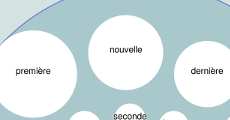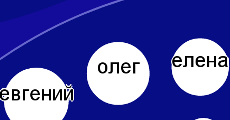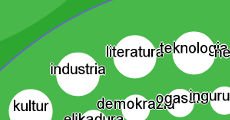ClusterCat induces word classes from unannotated text. It is programmed in modern C, with no external libraries. A Python wrapper is also provided.
Word classes are unsupervised part-of-speech tags, requiring no manually-annotated corpus. Words are grouped together that share syntactic/semantic similarities. They are used in many dozens of applications within natural language processing, machine translation, neural net training, and related fields.
You can use either GCC 4.6+ or Clang 3.7+, but GCC is recommended.
sudo apt-get update && sudo apt-get install gcc make
make -j 4
Until Xcode includes Clang 3.7+, you can use Homebrew to install a version of Clang that supports OpenMP:
brew update && brew install clang-omp
make -j 4 CC=clang-omp
The binary program clustercat gets compiled into the bin directory.
Clustering preprocessed text (already tokenized, normalized, etc) is pretty simple:
bin/clustercat [options] < train.tok.txt > clusters.tsv
The word-classes are induced from a bidirectional predictive exchange algorithm.
The format of the output class file has each line consisting of wordTABclass (a word type, then tab, then class).
Command-line argument usage may be obtained by running with program with the --help flag:
bin/clustercat --help
Installation and usage details for the Python module are described in a separate readme.
- Print word vectors (a.k.a. word embeddings) using the
--word-vectorsflag. The binary format is compatible with word2vec's tools. - Start training using an existing word cluster mapping from other clustering software (eg. mkcls) using the
--class-fileflag. - Adjust the number of threads to use with the
--threadsflag. The default is 8. - Adjust the number of clusters or vector dimensions using the
--classesflag. The default is approximately the square root of the vocabulary size. - Includes compatibility wrapper script
bin/mkclsthat can be run just like mkcls. You can use more classes now :-)
| Training Set | Brown | ClusterCat | mkcls | Phrasal | word2vec |
|---|---|---|---|---|---|
| 1 Billion English tokens, 800 clusters | 12.5 hr | 1.4 hr | 48.8 hr | 5.1 hr | 20.6 hr |
| 1 Billion English tokens, 1200 clusters | 25.5 hr | 1.7 hr | 68.8 hr | 6.2 hr | 33.7 hr |
| 550 Million Russian tokens, 800 clusters | 14.6 hr | 1.5 hr | 75.0 hr | 5.5 hr | 12.0 hr |
See bl.ocks.org for nice data visualizations of the clusters for various languages, including English, German, Persian, Hindi, Czech, Catalan, Tajik, Basque, Russian, French, and Maltese.
For example:
You can generate your own graphics from ClusterCat's output.
Add the flag --print-freqs to ClusterCat, then type the command:
bin/flat_clusters2json.pl --word-labels < clusters.tsv > visualization/d3/clusters.json
You can either upload the JSON file to gist.github.com, following instructions on the bl.ocks.org front page, or you can view the graphic locally by running a minimal webserver in the visualization/d3 directory:
python -m SimpleHTTPServer 8116 2>/dev/null &
Then open a tab in your browser to localhost:8116 .
The default settings are sensible for normal usage, but for visualization you probably want much fewer word types and clusters -- less than 10,000 word types and 120 clusters. Your browser will thank you.
The perplexity that ClusterCat reports uses a bidirectional bigram class language model, which is richer than the unidirectional bigram-based perplexities reported by most other software. Richer models provide a better evaluation of the quality of clusters, having more sensitivity (power) to detect improvements. If you want to directly compare the quality of clusters with a different program's output, you have a few options:
- Load another clustering using
--class-file, and see what the other clustering's initial bidirectional bigram perplexity is before any words get exchanged. - Use an external class-based language model. These are usually two-sided (unlexicalized) models, so they favor two-sided clusterers.
- Evaluate on a downstream task. This is best.
Contributions are welcome, via pull requests.
If you use this software please cite the following
Dehdari, Jon, Liling Tan, and Josef van Genabith. 2016. BIRA: Improved Predictive Exchange Word Clustering. In Proceedings of the 2016 Conference of the North American Chapter of the Association for Computational Linguistics: Human Language Technologies (NAACL), pages 1169–1174, San Diego, CA, USA. Association for Computational Linguistics.
@inproceedings{dehdari-etal2016,
author = {Dehdari, Jon and Tan, Liling and van Genabith, Josef},
title = {{BIRA}: Improved Predictive Exchange Word Clustering},
booktitle = {Proceedings of the 2016 Conference of the North American Chapter of the Association for Computational Linguistics: Human Language Technologies (NAACL)},
month = {June},
year = {2016},
address = {San Diego, CA, USA},
publisher = {Association for Computational Linguistics},
pages = {1169--1174},
url = {http://www.aclweb.org/anthology/N16-1139.pdf}
}




